The Drakesbrook School first opened in 1898 as a one room school in Centennial Park. In 1921 the Drakesbrook School changed its name to the Waroona State School. It remained open to the 1980s.
Originally, the school teacher’s house was located next to the school and children who rode to school tied their horses to pine trees near the building. The problem of overcrowding was such that in the 1903 report it was suggested opening schools at Hamel and Yalup Brook, or that at least two classrooms be added to the Drakesbrook School. However, by October 1903 attendance was down due to closure of the Waroona Mills, with the resulting loss of families from the district.
The school population continued to increase and in 1988 the primary school students and teachers moved to the Millar Street District High School location. The old school was one of the only two remaining pre-1900 weatherboard one-room school buildings in Western Australia. The 2005 fire left nothing of the old school but the bricks from the fireplace and a few other relics. The remaining building was removed but a year later the Council approved a memorial to the school to be built on the site. The Shire, Waroona Historical Scoeity, Fremantle Arts and Alcoa worked together to create the Drakesbrook School Memorial Footprint which stands in the centre of a community park as a symbol of days gone by and a reminder of the resolve of Waroona to preserve its history and retain its rural identity. The symbols represent games played by children in the olden days. These games include hopscotch, marbles and knuckle bones. The bell tower is a symbol of the school building and bell they used at the school.
North Drakesbrook School
The North Drakesbrook School was located about 5km north of Waroona amongst the pines on the South West Highway, opposite Hall Road. The school was opened on the 12th of September 1910 with 17 students and it closed 25th of June 1943.
The original building was a tent with a wooden frame covered with canvas and topped with an iron roof.
The school had to have at least 10 children to enrol before a school could be established, so a farmer’s wife, Mrs Margaret Bowles, was the main person involved in getting things started and built, when she wrote to the Educational Department in an attempt to get a school officially opened.
The first teacher was Mrs Lucy F. England and she taught for 12 months before a local woman, Mrs Nellie Roberts, took on the job and taught until 1940. Mrs Aileen Vera MacDonald commenced duties on the 5th February 1941 and taught until the school closed on the 25th June 1943.
The number of students jumped to 34 in 1923 and up to 40 children attended in later years, from infants to eighth class.
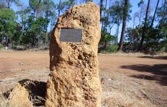
The tent was gradually enlarged and became more permanent weatherboard. A new school building was erected in 1926. All the children walked to school or came by horse and cart, and former students recall how play time was spent in baseball, rounders or on a maypole in the school grounds. When school closed in 1943, the children travelled by a bus into Waroona school.
A stand of pines on the west side of South Western Highway mark the spot where the school once stood.
Fettler’s Cottages
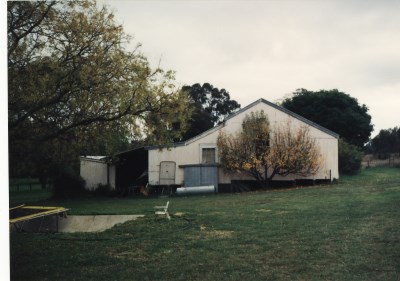 The Fettler’s Cottages are west of Nestlé’s factory on the other side of the railway line. The street name is Railway Reserve. There are three original Fettler’s cottages. These heritage listed dwellings dating back to the early days of Waroona, were erected shortly after the railway from Perth to Bunbury was completed in 1893.
The Fettler’s Cottages are west of Nestlé’s factory on the other side of the railway line. The street name is Railway Reserve. There are three original Fettler’s cottages. These heritage listed dwellings dating back to the early days of Waroona, were erected shortly after the railway from Perth to Bunbury was completed in 1893.
The Fettler’s cottages were occupied by workers on the railway line.
Now it has been turned into federation bungalow style single story residences with moderately pitched gabled broken back roof and front verandah. Some windows have been replaced with aluminium frames. The cottages are set down low and amongst mature trees.
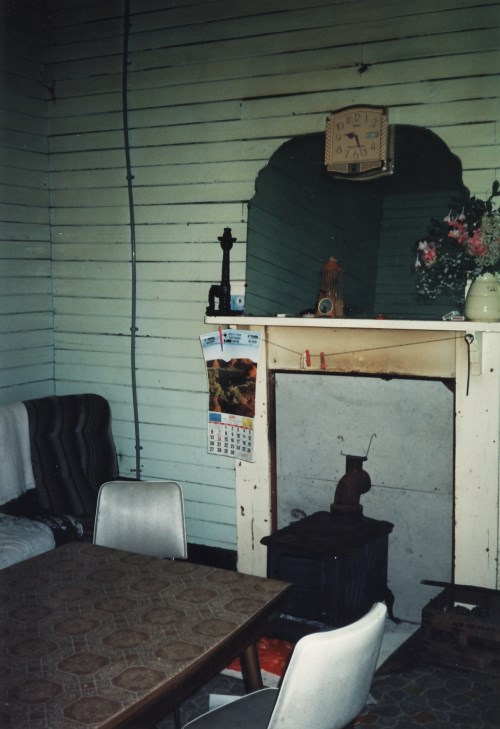
The Fettler’s Cottage's were built 1896 for the railway employees. The Drakesbrook Railway Station opened between 1893 and 1896, and was located on the east side of the railway line opposite the middle cottage.
Now the cottages are privately owned but you can still go to look at them and see what they are all about. The cottage was associated with the railway which was an important part of the development of Waroona today. You can still see the cottages but there is only one cottage left.
Memorial Hall and Drakesbrook Place
Where It is Located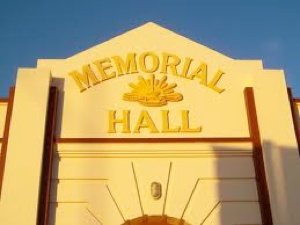
The Memorial Hall is located along the South Western Highway. The Memorial Hall is used for Anzac Day Commemoration, Waroona Show-for the art exhibition and many other exhibits at the show, showing movies, wedding receptions, concerts, public meetings and maybe fundraising events after World War 2
How to Hire the memorial hall
You can also use the Memorial Hall. Go to the Waroona Shire which is at 52 Hesse Street, Waroona WA 6215.
What is near the Memorial Hall
Near the Memorial Hall is the Waroona oval where the Waroona Demons play football and there is parking at the back of the club rooms and all around the oval.
Design & History
The Memorial Hall was designed by architects Powell, Cameron and Chisholm in 1932. It opened on 4 December 1934 on the eastern side of the South Western Highway between Millar and Parnell Streets, in front of the show grounds. It was of brick and stone construction, with a built-in bio-box for showing movies and had a corrugated iron roof.
Before the town was on the SEC power, Jack Madison, who was also manager of Waroona Electric Light Co, had the picture (movie) contract in the Memorial Hall for some years. In the 1940’s movies were shown by the Kanzler circuit operating out of Albany, it was then sold to Allan Jones of Busselton in 1949. Screenings ceased in the late 1960’s, but Roy Mudge of Perth screened movies there every second Friday from 8 November 1991 to 15 January 1994. The Hall had a separate room for the Return Service League (RSL) use. If you have a look on the side of this webpage there will be a video of Menzie’s visit to Waroona (the Prime Minister from 25th of July 1961). Not often do you see the Prime Minister coming to Waroona do you?
St Patrick’s Church
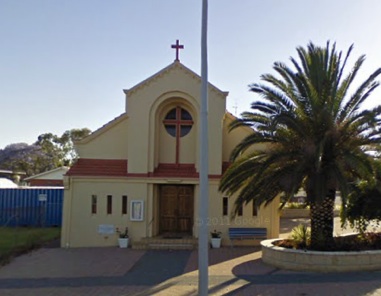 Early parish history goes back to 1890 when the first Mass was celebrated in the Wagerup in the home of Mr and Mrs Eastcott by Rev. Father Brady, Parish Priest of Bunbury. Within the next decade, Catholic families including the Fitzpatricks, Corrigans and McCabes who all settled in the Hamel area. The first mass in Drakesbrook (Waroona) was celebrated shortly after their arrival by Rev. Father Donogher in the Drakesbrook or Waroona Hall, at that time situated just north of the Drakesbrook school. Bishop Gibney visited Waroona in 1901 and administered the Sacrament of Confirmation in the hall.
Early parish history goes back to 1890 when the first Mass was celebrated in the Wagerup in the home of Mr and Mrs Eastcott by Rev. Father Brady, Parish Priest of Bunbury. Within the next decade, Catholic families including the Fitzpatricks, Corrigans and McCabes who all settled in the Hamel area. The first mass in Drakesbrook (Waroona) was celebrated shortly after their arrival by Rev. Father Donogher in the Drakesbrook or Waroona Hall, at that time situated just north of the Drakesbrook school. Bishop Gibney visited Waroona in 1901 and administered the Sacrament of Confirmation in the hall.
Soon after the Irish families settled on the 10 acre Hamel blocks they had bought (already cleared), from the Government, Bishop Gibney sent a well known Missioner, Rev. Father Clune to conduct a Mission. The Mission then decided that they needed a church. A block in Waroona on which to build the church was donated by Mr Barrett. In 1906 Rev. Father Clune travelled from Perth to bless and open St Mary’s - the only Catholic Church between Bunbury and Armadale at that time. The Parish Priest of Busselton, Rev. Father Donogher, came at frequent intervals to celebrate Mass.
In 1909 the districts of Pinjarra, Waroona, Yarloop and Harvey were constituted, a Priest, Rev. Father Fahey became parish priest and resided in Yarloop until he was succeeded by Rev. Father McCabe and later Father Doddy. In 1939 Father Power was made Parish Priest. The present day St Patricks Church was built opened in 1941 and replaced St Mary’s. The official opening was held on 19 August 1941that year and blessed by the most Rev. R. Prendiville.
The Nestle Factory
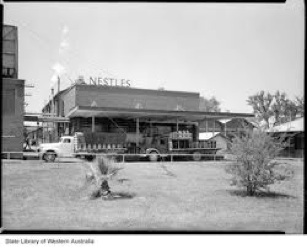 The Nestle Factory was opened in 1932 and was producing condensed milk from fresh milk purchased from dairy farmers around the district. At this time there were 30 to 40 dairy farms in the Hamel and Cookernup areas. The factory is on 15 hectares and that is about 25 acres. The factory is located on the corner of Mclarty and Fouracre Street.
The Nestle Factory was opened in 1932 and was producing condensed milk from fresh milk purchased from dairy farmers around the district. At this time there were 30 to 40 dairy farms in the Hamel and Cookernup areas. The factory is on 15 hectares and that is about 25 acres. The factory is located on the corner of Mclarty and Fouracre Street.
In 1949 the number of milk suppliers rose to 120 and in 1950, milk from these suppliers, plus surplus milk from Wagerup and Brunswick milk depots saw a rise in flush months to nearly 16,000 gallons (60,566 litres), a day maximum. In the processed form this represented 64,000 pounds (29,029 kilograms) of sweetened condensed milk. In September 1935 the Nestle factory was receiving milk from 653 milk dairy cows and in September 1936 it was receiving milk from 951 cows - that is almost a 50% increase. The Nestlé’s factory in Waroona was donating a trophy cup to a local producer with the best three dairy cows and also three cows and one bull of any breed.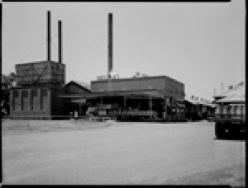
The Nestle factory closed in 1966 and it was sold to Peters Creameries. Not long after the land was put up for sale and Charles Hull Contracting purchased the site and used it as their main base for some time prior to moving to their present site. In 1983 the demolition of the smoke stack (chimney) took place.
The Nestle factory was actually built in Waroona, Western Australia and the condensed milk was imported all over the world and there are still some Nestle factory cans that have the label on the front saying Made in Waroona, Western Australia, but they are very rare.
Waroona Sofa
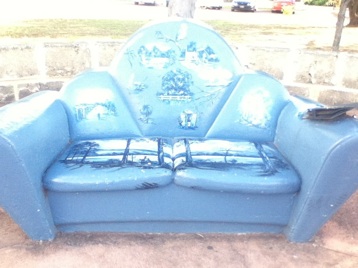
In the centre of town you will find Waroona’s concrete sofa which was once covered by a patchwork quilt. About 20 local people created pieces portraying something important about their lives in Waroona to make the sofa. Due to deterioration of the fibreglass coating it was necessary to refurbish the sofa in 2008 by stripping back the fibreglass and removing the quilt pieces.
The sofa was part of a Sofa Trail that was constructed about ten years ago, there are ten painted sofas located in different towns including Fremantle, Kwinana, Rockingham, Mandurah, Pinjarra, Dwellingup, Yarloop, Harvey and Bunbury. Many of them have been largely forgotten. Some have suffered ravages over the time but the sofa in Waroona has been very well maintained.
The concrete sofa weighs a total of 2.4 tonnes. Each piece of concrete slab weighing 300 kg. If you want more information you can go to Mrs. Goldsworthy at the Waroona visitors centre.
The original design covering the sofa was removed taking 6 people to complete the job. The new-look sofa has been re- painted by local artist Lorraine Bawden with scenes showing 'old' Waroona, local flora and fauna, and places of interest.